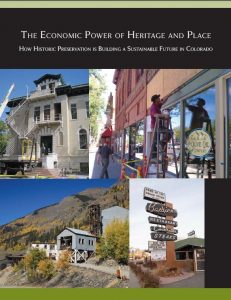 Did you know that if you own a historic building, you own an economic asset? Studies have proven that the preservation of historic structures is directly linked to a stronger economy. Historic places attract tourists, encourage investment in community, promote sustainability, and can provide owners with state and federal tax credits. It’s all outlined in a new recent study from the Colorado Office of Archaeology and Historic Preservation entitled The Economic Power of Heritage and Place: How Historic Preservation is Building a Sustainable Future in Colorado. A previous study from this office, The Economic Benefits of Historic Preservation in Colorado, further describes why historic preservation is a financially sound idea. If you’re deciding whether to keep a historic building or replace it with a new one, keep some of these facts in mind: 1) you can get tax credits for preserving a historic building that you couldn’t get with a new structure — that means money in your pocket. 2) Owners of commercial and public buildings can apply for State Historical Fund grants. 3) Historic buildings were built to last for hundreds of years. Today’s new construction is only meant to last for fifty years. 4) Waste from building demolition is the second-highest contributor to landfills in America, after paper. As any preservationist will tell you, “the greenest building is the one already built.” So invest in your community today and consider the outstanding economic benefits of historic preservation.
Did you know that if you own a historic building, you own an economic asset? Studies have proven that the preservation of historic structures is directly linked to a stronger economy. Historic places attract tourists, encourage investment in community, promote sustainability, and can provide owners with state and federal tax credits. It’s all outlined in a new recent study from the Colorado Office of Archaeology and Historic Preservation entitled The Economic Power of Heritage and Place: How Historic Preservation is Building a Sustainable Future in Colorado. A previous study from this office, The Economic Benefits of Historic Preservation in Colorado, further describes why historic preservation is a financially sound idea. If you’re deciding whether to keep a historic building or replace it with a new one, keep some of these facts in mind: 1) you can get tax credits for preserving a historic building that you couldn’t get with a new structure — that means money in your pocket. 2) Owners of commercial and public buildings can apply for State Historical Fund grants. 3) Historic buildings were built to last for hundreds of years. Today’s new construction is only meant to last for fifty years. 4) Waste from building demolition is the second-highest contributor to landfills in America, after paper. As any preservationist will tell you, “the greenest building is the one already built.” So invest in your community today and consider the outstanding economic benefits of historic preservation.Latest posts by Amy Zimmer (see all)
- How to Spot the Differences Between Eagles and Hawks - August 16, 2021
- How Transportation Projects Help Tell the Story of Colorado’s Past - August 9, 2021
- Time Machine Tuesday: The Night the Castlewood Canyon Dam Gave Way - August 3, 2021